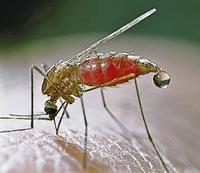-
New virus could be the first filovirus to cause disease in bats

A team of international researchers has discovered a new Ebola-like virus — Lloviu virus — in bats from northern Spain; filoviruses, which include well-known viruses like Ebola and Marburg, are among the deadliest pathogens in humans and non-human primates, and are generally found in East Africa and the Philippines
-
-
Google Earth typhoid maps traces disease outbreaks
Recent advances in DNA sequencing have allowed scientists accurately to track the spread of some diseases by measuring mutations in the pathogen’s DNA when the DNA replicates; tracing the spread of typhoid, however, has proved challenging because these mutations are small in number and not detectable by most techniques in use
-
-
Elusive killer parasite being traced in Peru
Chagas disease, primarily seen in South America, Central America, and Mexico, is the most deadly parasitic disease in the Americas; Penn epidemiological study takes snap shot of long-term Chagas disease outbreak
-
-
Real-time disease monitoring can help improve diagnoses
Discovering epidemics or knowing when one is brewing is particularly difficult at the local level as doctors lack a broader perspective of what is occurring; to help provide local doctors with better information that could help stem the spread of infectious diseases, public health officials are pushing for the creation of a real-time national disease monitoring system
-
-
Japanese attenuated smallpox vaccine shows promise in U.S. trial
An attenuated smallpox vaccine that was developed in Japan in the 1970s compared well with a conventional smallpox vaccine in a phase 1-2 clinical trial in the United States
-
-
Mapping the spread of drug-resistant influenza

The movie “Contagion” is not based on real events, but it is not science fiction, either: certain strains of influenza are becoming resistant to common treatments; a team of researchers map out how this phenomenon is happening globally
-
-
Biological weapons: U.S. must not repeat the failure of imagination
Joel McCleary, a biological weapons expert, is the chairman and co-founder of Q Global and the founder of PharmAthene; he argues that the U.S. government has not done enough to protect the nation against a biological attack, warns of the need for presidential leadership, and underscores the dangers of biological weapons
-
-
Anthrax forensics help ID source of Haitian cholera outbreak
Researchers have discovered the source of the deadly cholera outbreak in Haiti that killed more than 6,000 people and sickened 300,000; the study determined that Nepalese peacekeepers brought cholera to Haiti, when they came to assist the country’s rebuilding efforts following the massive earthquake in January 2010
-
-
How did the deadly plague bacterium develop?

In a relatively short time — in evolutionary terms — a bacterium that causes mild stomach irritation evolved into a deadly pathogen responsible for the most devastating pandemics in human history; how did the mild-mannered Yersinia pseudotuberculosis become Yersinia pestis, more commonly known as the Plague? New study explains what happened — and sheds light on fighting deadly diseases
-
-
Experts anxious about appearance of a variant strain of Bird Flu

Since 2003 H5N1 has killed or forced the culling of more than 400 million domestic poultry and caused an estimated $20 billion of economic damage across the globe before it was eliminated from most of the sixty-three countries infected at its peak in 2006; the UN health agency now calls for increased preparedness and surveillance against a re-emerging variant strain of H5N1
-
-
The malaria mosquito is disappearing – researchers wonder why

The incidence of malaria in many African countries south of the Sahara is falling rapidly; a research group has discovered that the mosquito carrying the malaria parasite has practically disappeared from villages without organized mosquito control; there are several hypotheses about the cause of the decline, but without proper data researchers cannot say whether malaria is being eradicated or whether it is just resting up before returning with renewed vigor
-
-
Common bacterium stops mosquitoes from transmitting Dengue virus
Strains of a bacterium commonly found in fruit flies can prevent the Aedes aegypti mosquito from transmitting the virus that causes dengue fever, researchers have found; the discovery could lead to a more effective way to control dengue worldwide
-
-
Overcoming dangerous antibiotic-resistant bacteria
Scientists have successfully reengineered an important antibiotic to kill the deadliest antibiotic-resistant bacteria; the compound could one day be used clinically to treat patients with life-threatening and highly resistant bacterial infections
-
-
Source of Haitian cholera outbreak identified
Employing technology that reads the entire DNA code, researchers have pinpointed the source of a cholera outbreak in Haiti that killed more than 6,000 people and sickened 300,000; the researchers also suggest how to prevent future outbreaks when international aid is rushed to disaster areas
-
-
How did H1N1 become an pandemic?

The last century has seen two major pandemics caused by the H1N1 virus — the Spanish Flu in 1918 and 2009’s Swine Flu scare, which had thousands travelling with surgical masks and clamoring for vaccination; scientists, however, did not know what distinguished the Swine Flu from ordinary influenza in pigs or seasonal outbreaks in humans, giving it the power to travel extensively and infect large populations; until now
-
- All
- Regional
- Water
- Biometrics
- Borders/Immig
- Business
- Cybersecurity
- Detection
- Disasters
- Government
- Infrastructure
- International
- Public health
- Public Safety
- Communication interoperabillity
- Emergency services
- Emergency medical services
- Fire
- First response
- IEDs
- Law Enforcement
- Law Enforcement Technology
- Military technology
- Nonlethal weapons
- Nuclear weapons
- Personal protection equipment
- Police
- Notification /alert systems
- Situational awareness
- Weapons systems
- Sci-Tech
- Sector Reports
- Surveillance
- Transportation
Advertising & Marketing: advertise@newswirepubs.com
Editorial: editor@newswirepubs.com
General: info@newswirepubs.com
2010-2011 © News Wire Publications, LLC News Wire Publications, LLC
220 Old Country Road | Suite 200 | Mineola | New York | 11501
Permissions and Policies
Editorial: editor@newswirepubs.com
General: info@newswirepubs.com
2010-2011 © News Wire Publications, LLC News Wire Publications, LLC
220 Old Country Road | Suite 200 | Mineola | New York | 11501
Permissions and Policies
